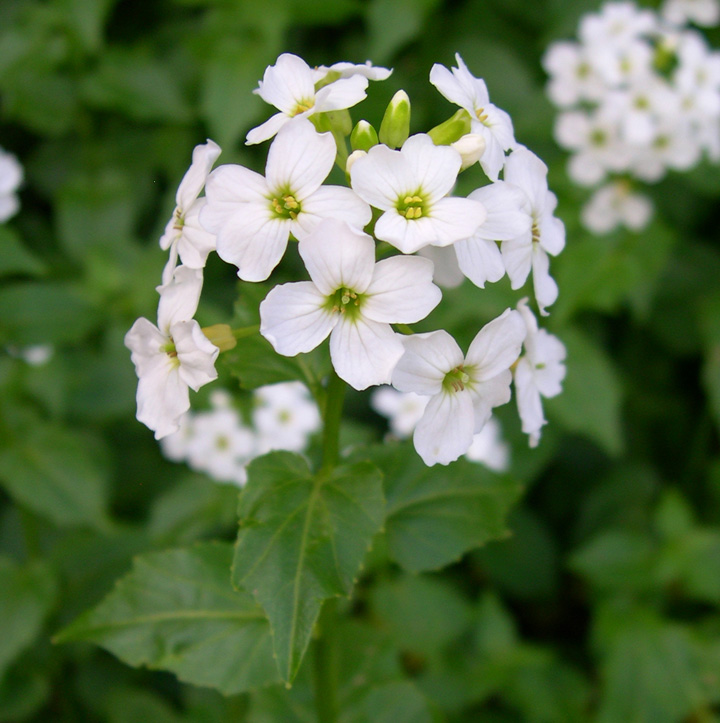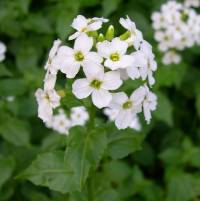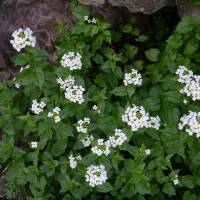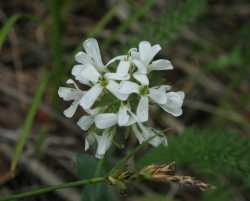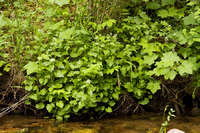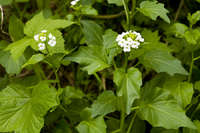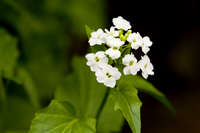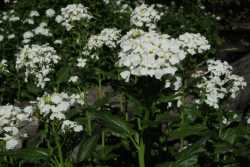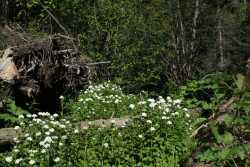Perennials; glabrous or densely puberulent. Rhizomes cylindrical, slender or stout, 1.5-3 mm diam., (not fleshy). Stems erect, unbranched or branched distally, 2-7(-10.2) dm, glabrous or sparsely to densely puberulent basally or throughout. Rhizomal leaves usually absent, rarely present, simple, 5-15 cm; petiole 2.5-12 cm; blade reniform to cordate, 1.5-4.5(-6) cm. Cauline leaves (3-)5-17(-23), simple or, rarely, proximalmost 3-foliolate, petiolate; petiole 1-6.5(-8.5) cm, base not auriculate; blade reniform, deltate-cordate, or ovate-cordate, (1-)2-7.2(-9.7) cm × 10-55(-85) mm, (somewhat fleshy), base cordate or truncate, margins crenate to slightly sinuate, (veins ending in apiculae, surfaces glabrous or sparsely to densely pubescent). Racemes ebracteate. Fruiting pedicels divaricate to ascending, (7-)10-20 mm. Flowers: sepals oblong, 2.5-4.5 × 1.5-2 mm, lateral pair slightly saccate basally; petals white, broadly obovate, 7-12 × 4-6 mm (claw to 6 mm, apex rounded to subtruncate or emarginate); filaments: median pairs 3.5-5 mm, lateral pair 2-3.5 mm; anthers oblong, 1-1.5 mm. Fruits linear, (2-)2.5-3.7(-4) cm × 1.2-2 mm; (valves glabrous or sparsely puberulent); ovules 14-24 per ovary; style 0.5-3(-6) mm. Seeds brown, oblong, 1.6-2 × 1-1.3 mm. 2n = 24.
Flowering May-Aug. Stream banks, springs, shady gullies, creek bottoms, lakeshores, ponds, cold springs, meadows, moist hillsides, mossy areas, alpine streams, mixed coniferous forests; 600-3600 m; B.C.; Ariz., Calif., Colo., Idaho, Nev., N.Mex., Oreg., Utah, Wash., Wyo.
Cardamine cordifolia is highly variable in leaf morphology, especially in leaf width, depth of the cordate base, and indumentum. This variation occurs throughout the species range and is rather weakly or not at all correlated with geography. In the absence of a detailed biosystematic study over the entire species range, we follow N. H. Holmgren (2005b) in not recognizing any infraspecific taxa, instead of accepting the three rather poorly defined varieties recognized by R. C. Rollins (1993).
General: Perennial, 20-80 cm tall; stems erect, simple to seldom branched above; herbage glabrous to densely puberulent; rhizomatous.
Leaves: Cauline, alternate, simple, ovate to kidney-shaped, the lower leaves sometimes orbicular, 2-7 cm long, 1.5-5 cm wide, somewhat fleshy, glabrous, rarely pubescent, margins coarsely crenate to shallowly wavy, base cordate or occasionally truncate; petioles 1-6 cm long, usually shorter than the blade.
Flowers: Inflorescence a many-flowered raceme, the flowers minute; pedicels 10-15 mm long, spreading to ascending; sepals ovate, 1-2 mm long, green, often with a reddish tinge, glabrous to pubescent; petals oblanceolate to spatulate, 2-3 mm long, white; flowers March-September.
Fruits: Silique, ascending to erect, linear, 2-4 cm long, slightly flattened; seeds numerous, arranged in 1 row.
Ecology: Streambanks, seeps, moist habitats, aspen, spruce-fir, alpine tundra communities; 2700-3400 m (9000-11000 ft); Apache, Coconino, Gila, and Yavapai counties; southwestern Canada, western and southwestern U.S.
Notes: Cardamine cordifolia is a host plant for the mustard white butterfly.
Editor: Springer et al. 2008


